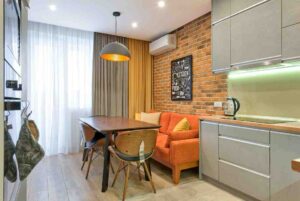
Interior spaces are no longer merely transformed by indoor plants, but made real by them. This innovative concept of Adaptive Plant Zoning allows homeowners to use their living areas as versatile, multi-purpose zones, serving a variety of purposes. By utilizing this approach indoor greenery becomes natural dividers, mood enhancers, and functional design elements that contribute to a harmonious blend of aesthetics and function.
In this guide, we’ll walk you through Adaptive Plant Zoning, all its spoils and find some clever ways to turn your abode into a living, breathing, horticulturally enriched space.
What is Adaptive Plant Zoning?
Strategic use of plants for creating, defining and transforming indoor spaces for purpose is called Adaptive Plant Zoning. Unlike traditional plant arrangements, this is a flexible concept. It facilitates plants to cope up with the changing requirements in a home, say carrying out the space into smaller ones, adding a thoughtful resting place, or even filling a room with intimate areas for meals or chatting.
The perfect application for our current lifestyle, where multifunctional spaces have become essential, this method is perfectly aligned with modern lives. No matter if you are living in a tiny apartment or an expansive home, the natural beauty and utilization of your interiors is catered by way of Adaptive Plant Zoning.
Why is Adaptive Plant Zoning Important?
Ultimately, Adaptive Plant Zoning is concerning itself with much more than just aesthetics. It presents a real and environmentally friendly way to make your living spaces versatile and coherent. Here’s why it matters:
- Enhances Functionality: It allows plants to be sound barriers, light filters and a privacy screen, making your space more usable.
- Promotes Well-Being: It brings the living experience of a better place to breathe, lower stress and boost mood, all while improving air quality by bringing in greenery.
- Maximizes Space: Plants truly define the spaces in rooms, which also means you don’t have to have heavy furniture or walls.
- Eco-Friendly Design: Using plants as dynamic design elements reduces reliance on synthetic materials, which is in line with sustainable living principles.
- Create a Personal Atmosphere: Each plant space can be styled to reflect your mood, needs or personality. Make your home truly unique.
How to use adaptive plant zoning in your home.
1. Start by evaluating the layout.
Start by analyzing your living space. Identify areas that need zoning, such as work areas, relaxation corners or dining areas. Pay attention to:
- Light Availability: Consider which areas receive natural light and which plants need artificial light.
- Traffic Patterns: Ensure that the placement of trees does not impede movement through the area.
- Existing furniture: Use plants to complement and update current decor without cluttering up the space.
2. Choose purpose-driven plants.
The plants you choose should reflect the functionality of each area. Here are some examples:
- Work Area: Use tall plants, such as snake trees or rubber trees. They are low maintenance and clean the air. To create a calm and focused environment…
- Relaxation area: Choose ferns. peace lily or lavender to create a tranquil atmosphere.
- Where to eat: Citrus trees or aromatic herbs like rosemary and thyme add to the beauty and dining experience.
- Entrance: Tall plants such as palm trees or monstera can create a delightful appearance.
3. Use a mobile planter for flexibility.
Adaptability is key to this concept. Invest in a lightweight, portable plant pot with wheels that can be moved as needed. This is especially useful when creating temporary spaces, such as separating work areas during the day. and opening a resting area in the evening…
4. Combine vertical and floor zoning.
Take advantage of vertical space by incorporating hanging plants. wall mounted planter or a tiered plant stand Placing trees in layers Different heights add depth and interest to your space. For example:
- Tall plants: Bamboo or vine leaves to create a privacy screen.
- Medium-sized plants: Rubber trees or philodendrons for mid-range accents.
- Low-growing plants: Moss, succulents, or climbing vines for ground-level detail.
5. Add zoning with accessories
Combine plants with functional and decorative accessories to further define the space. For example, use a rug, lighting or shelving to complement your plant arrangement.
Creative field ideas using adaptive plant zoning
1. Green work space
Turn your living room corner into a productive and inspiring workspace by using tall leafy plants as a screen. Pair it with a small table and ergonomic chair to create a focused environment.
2. Comfortable relaxation corner
Design a quiet reading or meditation corner using light greens. that are arranged in layers, such as pothos or pearl necklaces Add a comfortable chair, a blanket, and dim lighting. To complete your holiday
3. Dynamic dining area
Enhance your dining room by setting the table with a small orange tree. or fragrant plants These things not only make the area beautiful. But it also has a fresh scent and food decoration.
4. Transitional spaces
Use plants to create transitions between rooms. For example, a row of tall plant pots can define the boundary between the living room and kitchen without using a wall.
5. Multi-purpose residence
In design with an open concept Plants can be used to create different areas for relaxing, entertaining and dining. while maintaining the same appearance.
Advanced techniques of adaptive plant zoning
1. Integration of biophilic technology
Integrating smart devices such as automatic watering systems or light sensors To optimize space to maintain plant health effectively
2. Seasonal adjustments
Rotate plants or rearrange the space according to seasonal changes. For example, bring in flowering plants in spring and summer. And try planting winter-hardy deciduous trees.
3. Environmentally friendly materials
Use recycled or sustainable planters, organic fertilizers, and energy-efficient lighting to suit your eco-conscious lifestyle.
Advantages
Use raised floors: Plants help you make the most of every square inch of your home. Especially in small areas
Customizable design: You can change the space to meet your changing needs or mood.
Better air quality: Plants naturally purify the air. Create a healthier indoor environment.
Reduce noise pollution: Dense greenery absorbs sound. Make your home quiet
Eco-conscious living: Adaptive plant zoning promotes sustainability by reducing reliance on screens or built-in decorations.
gathering together
Flexible plant zoning is a game changer in modern interior design. It helps you transform your home into a vibrant, multi-purpose space that reflects your style and meets your needs. Creative use of plants allows you to customize your workspace, relaxation, dining, and more, while enjoying the beauty and benefits of indoor green space.
Termination record
Whether you’re a plant enthusiast or just starting out with indoor gardening, Adaptive Plant Zoning is an inspiring way to improve your living environment. Start a small Experiment with a variety of plants. and watch your home transform into a living, adaptable haven.
FAQ
What is adaptive vegetative zoning?
Flexible plant zoning is a method of using plants to define and transform flexible areas within your home.
What plants are best for adaptive plant zoning?
Plants such as fig leaf figs, snake plants, pothos plants, and ferns work well for creating a multi-purpose workspace.
Can adaptive plant zoning work in small spaces?
Yes, it is ideal for small spaces as it maximizes efficiency through compact plants and vertical placement.
How do I care for plants in Adaptive Plant Zoning?
Watering, pruning and ensuring proper light and humidity for each plant on a regular basis. Helps the rice fields be healthy and lively.
What are the benefits of adaptive zoning?
Increase efficiency Increase air quality create privacy and promote environmentally friendly living spaces
Can I easily move plants in Adaptive Plant Zoning?
Yes, using lightweight planters or ones with wheels allows you to easily rearrange your space to suit your needs…


